Beech mushrooms and enoki mushrooms have a lot in common. Many Asian cultures prize them for their medicinal and culinary benefits, both are edible, and they both have similarly long stems and small caps. However, there are a few ways in which they are different too! This article compares beech and enoki mushrooms so that you can learn their similarities and differences and how you can use each one.
Key Points
- Both beech mushrooms and enoki mushrooms grow in wild forest environments in Asia
- Both are staples of Asian cuisine, though beech mushrooms are more difficult to cultivate and can be expensive, while enoki mushrooms are relatively easy to cultivate and are one of the most popular mushrooms to eat
- Beech mushrooms have a nutty, umami flavor while enoki mushrooms have a sweet, fruity, mild flavor.
This article will go over where beech and enoki mushrooms grow. We will describe what they look like. We will also learn the history of each and discover how to use both of these species. Let’s learn more about these two species now!
Beech Mushrooms vs. Enoki Mushrooms
Beech Mushrooms vs. Enoki Mushrooms
Description of Beech Mushrooms
The species known as a “beech mushroom” is the edible fungus Hypsizygus tessulatus. Hypsizygus tessulatus goes by the names “white beech mushroom,” “brown beech mushroom,” and many others in Chinese, Japanese, and Korean. Beech mushrooms are very popular edible mushrooms in Asia, where they grow natively in China and Japan. They gained their nickname of “beech mushroom” from growing among dead and decaying beech trees, as well as around other trees such as elms.
You may split this species into two groups: brown beech mushrooms and white beech mushrooms. In general, the two have a similar appearance: smooth, small, round caps and long stems. However, they can either be white with white stems or brown with light brown stems. These two variations are the same species, but with different colors and flavor profiles.
Because these mushrooms appear in clusters and have such long, delicate stems and small caps, you will often find beech mushrooms sold in bouquets.
Beech mushrooms are among the most popular edible mushrooms in Asia, and appear in recipes for many different dishes both raw and cooked. With a savory, nutty taste and distinctive crunch, beech mushrooms bring unique flavor and texture to many different recipes.
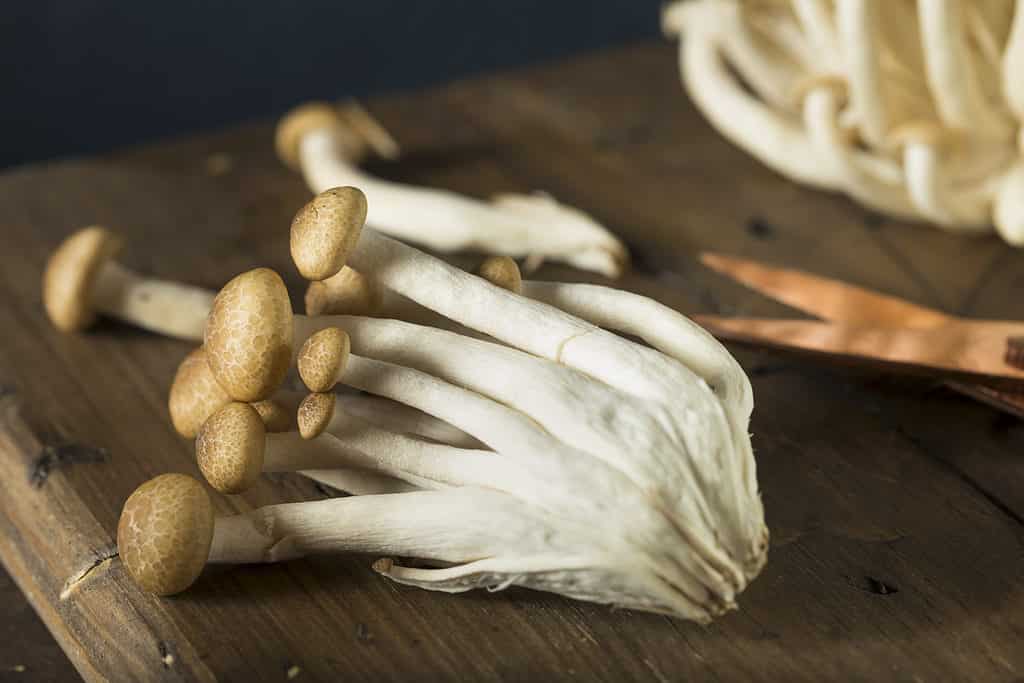
©Brent Hofacker/Shutterstock.com
Description of Enoki Mushrooms
The species Flammulina filiformis is commonly known as the “enoki mushroom.” Enoki mushrooms grow on dead wood of species such as birch trees and mulberry trees in its native environment of the forests of China, Japan, and Korea, though it also appears in the woods of North America. Cultivated enoki mushrooms grow in tight clusters that look a lot like bouquets.
Much like the beech mushroom, this mushroom has small, rounded, white caps and long, crunchy stems. Enoki mushrooms are edible and often appear in Asian cooking, where the stems add a delicious crunch and the caps bring an earthy, slightly fruity flavor and chewiness.
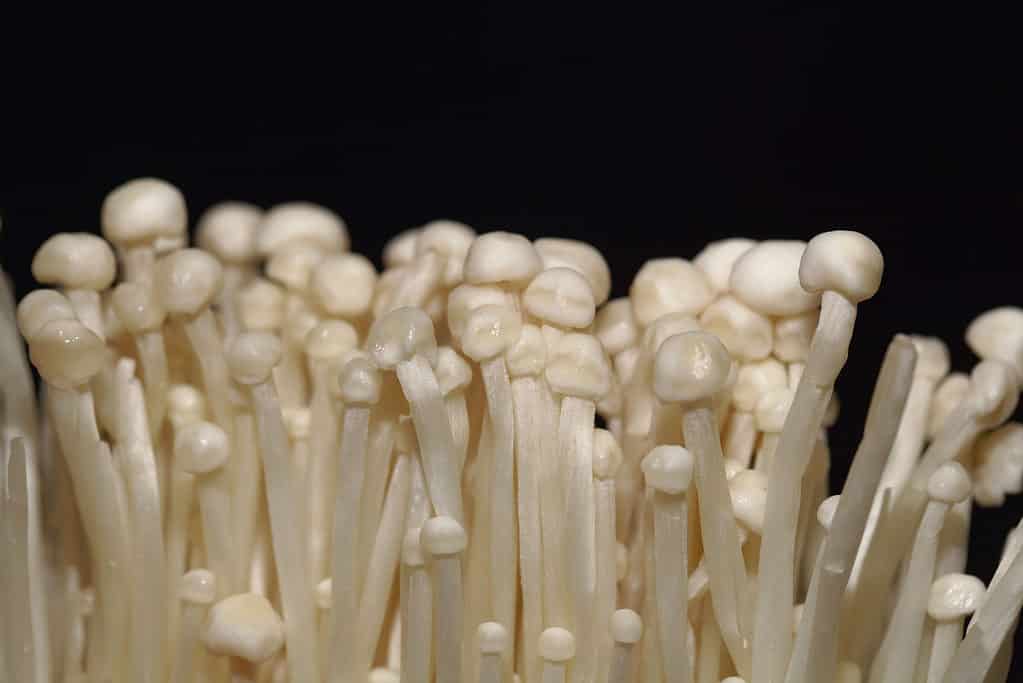
©iStock.com/weisschr
Beech Mushrooms vs. Enoki Mushrooms: Key Differences
Already, you can likely see that beech mushrooms and enoki mushrooms have a lot in common. They originate from Asia, have similarly long white stems and small caps, often come in the same color, and are popular in Asian cooking. However, the two have a few distinct differences. Let’s learn more about these similarities and differences as we compare and contrast the two now.
History and Origins of Beech Mushrooms
Beech mushrooms are native to East Asia, particularly the countries of China, Japan, and Korea. There, they can be found growing on hardwood tree species. Because they are often discovered among beech trees, they gained their nickname – however, they also grow among other tree species. The species Hypsizygus tessulatus is actually a variation of a “hon-shimeji,” which describes a group of edible mushrooms. Today, Hypsizygus tessulatus grows in East Asia, as well as in other parts of the world, including in Europe and North America.
There are two population variations of beech mushrooms, which you can distinguish by their color. The “brown beech mushroom,” also known as the “Buna-shimeji” originates from Japan and grows in the wild. Its counterpart, the “Bunapi-shimeji,” also originates from Japan, but is known as the “white beech mushroom.” This one is grown commercially. Though they are the same species, white beech mushrooms and brown beech mushrooms have different flavor profiles, and therefore, different uses.
However, both variations are part of a long history of mushrooms used for culinary and medicinal purposes throughout the world, and particularly in the Asian cultures from which the beech mushroom originates. Beech mushrooms are primarily commercially produced, though they do exist in the wild in parts of Asia, Europe, and North America. However, they have gained widespread cultivation as among the most popular mushrooms to eat in Asia.
History and Origins of Enoki Mushrooms
Enoki mushrooms are also native to East Asia, where their history can be traced back thousands of years. For centuries, enoki mushrooms have been cultivated in China and Japan, where they have an esteemed position in both cuisine and medicine. In Chinese culture, enoki mushrooms have long been used to relieve symptoms related to digestion, blood pressure, and liver disease. In Japanese culture, enoki mushrooms have often been used to make teas, soups, and other dishes to impart various health benefits.
Historically, experts believed that the wild enoki mushroom Flammulina velutipes was one and the same with the Asian species Flammulina filiformis. Flammulina velutipes grows across North America and Europe, and was believed to be the same species as found in Asia, just geographically spread out. Now the two are known to be separate, distinct species, but when they appear in the wild, they look nearly identical.
As a mushroom that has been cultivated since ancient times, enoki mushrooms have long been grown for human consumption. However, today, enoki mushrooms are one of the most commonly-produced mushrooms in the world. In fact, they are fifth in the rankings of all mushrooms cultivated globally!
Beech Mushrooms vs. Enoki Mushrooms: Appearance
Beech mushrooms and enoki mushrooms are often compared because they do have a somewhat similar appearance, with several unique and notable shared features.
As described previously, you may organize beech mushrooms into two varieties: brown beech mushrooms and white beech mushrooms. The brown beech mushrooms have small, rounded, and light brown caps over a white or off-white stem. In comparison, white beech mushrooms have rounded white caps over white stems. These stems are typically 2 to 3 inches long, and the caps are usually small – less than an inch across. These mushrooms grow in clusters together, but can be trimmed and separated before cooking. You will find beech mushrooms growing in clumps on dead and dying beech trees.
Like beech mushrooms, in the wild, enoki mushrooms grow on rotting wood. In some ways, enoki and beech mushrooms have similar features. Enoki mushrooms also have long, thin stems and bulbous caps. However, their caps are much smaller and their stems are longer. Enoki mushrooms have stems that can reach 3 to 4 inches high, but which are topped by a small, white cap that is only a quarter or half an inch across! These mushrooms grow in clusters that can be 6 or 7 inches long and range in color from bright white to more of a yellow, golden color.
Wild enoki look quite different from the enoki cultivated by commercial producers. In the wild, enoki mushrooms tend to have larger caps and more yellow or tan stems. The cultivated mushrooms have less natural light exposure, causing white fruit bodies with smaller caps and longer stipes (stems).
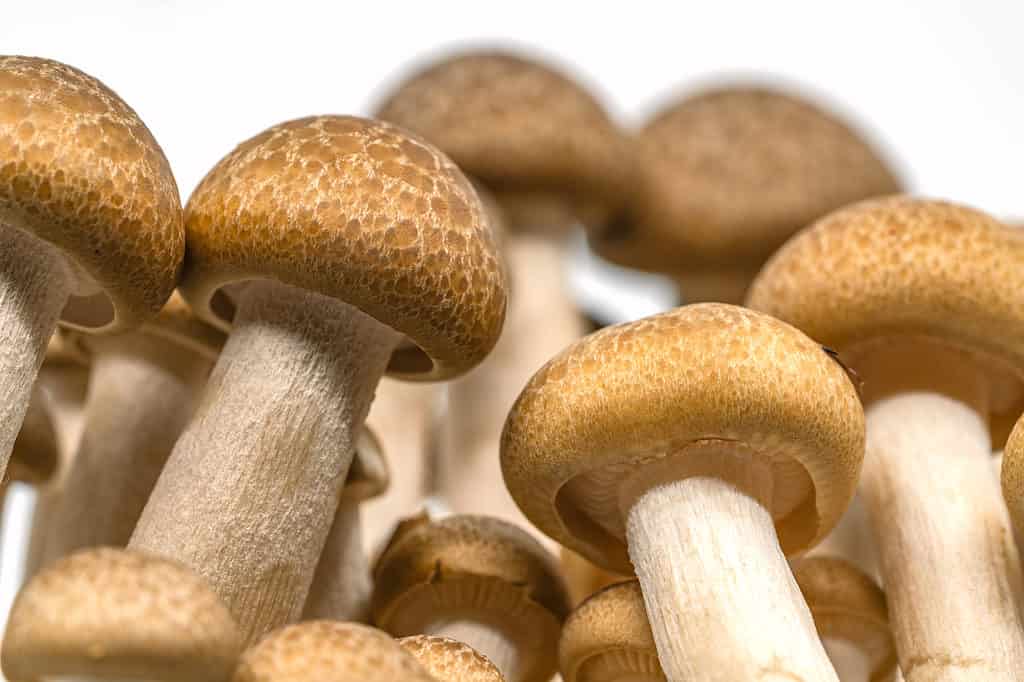
©somdul/Shutterstock.com
Beech Mushrooms vs. Enoki Mushrooms: Growing Conditions
Growing Conditions for Beech Mushrooms
Beech mushrooms are a mycorrhizal mushroom species. In the forests where they grow natively in East Asia, mushroom species in the Shimeji group, which include the beech mushroom species Hypsizygus tessulatus, thrive. As mycorrhizal mushrooms, beech mushrooms thrive in a symbiotic relationship with the nearby forest trees. These mushrooms grow on beech trees and other hardwood species. However, they do not attack the living tree tissue like a parasitic species would. Nor do they live only on dead wood like a saprotrophic species would. Rather, beech mushrooms develop in the soil near the roots of trees, where they gain nutrients while supporting the health of the tree itself.
Beech mushrooms are somewhat difficult to cultivate. As a mycorrhizal species, they need the roots of living trees in order to survive and gain nutrients. Because they are more challenging to produce, they are relatively rare and a more expensive mushroom to purchase compared to other species. Nevertheless, beech mushrooms are among the most popular mushrooms found in the cuisines of Asia, Korea, and Japan.
Growing Conditions for Enoki Mushrooms
In comparison, enoki mushrooms are easily cultivated, but can be very different when grown commercially from what you would find in the wild. In the native environment, wild enoki mushrooms appear on rotting wood. Various enoki mushrooms appear often on elms and other tree species in Asia. In the wild, enoki thrive in cooler temperatures and grow on living and dead trees, often in clusters.
The pure white enoki that most people find in the grocery stores and dishes are cultivated enoki. These are quite different, with long and thin stems, tiny caps, and dense clumps. These enoki are cultivated on aged sawdust made from hardwood trees, packed into tight containers and then inoculated with spawn from the enoki fungus. When cultivated this way, the enoki develop long stems as they grow in the dark and reach out to try to find a source of light.
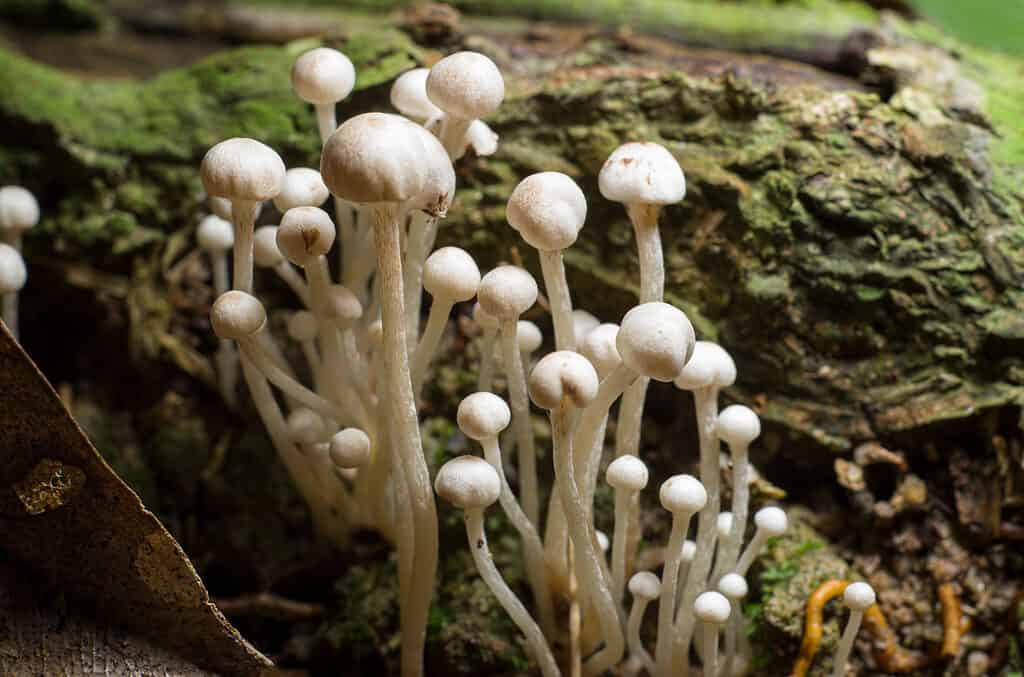
©iStock.com/Wirestock
Beech Mushrooms vs. Enoki Mushrooms: Scent and Taste
Beech mushrooms are often described as having a sweet, nutty taste. These are often cooked in a pan with butter or oil, and added as a garnish on top of meat or other foods. However, the exact flavor of beech mushrooms varies depending on whether it is a white beech mushroom or brown beech mushroom. The brown beech mushrooms have a more rich, savory flavor, while the white beech mushroom tastes more mild and sweet. Their stems are fully edible and bring a wonderful crunch, just trim off the tough end. You can eat beech mushrooms either raw or cooked – however, many prefer the way that cooking softens the bitterness of the uncooked mushroom.
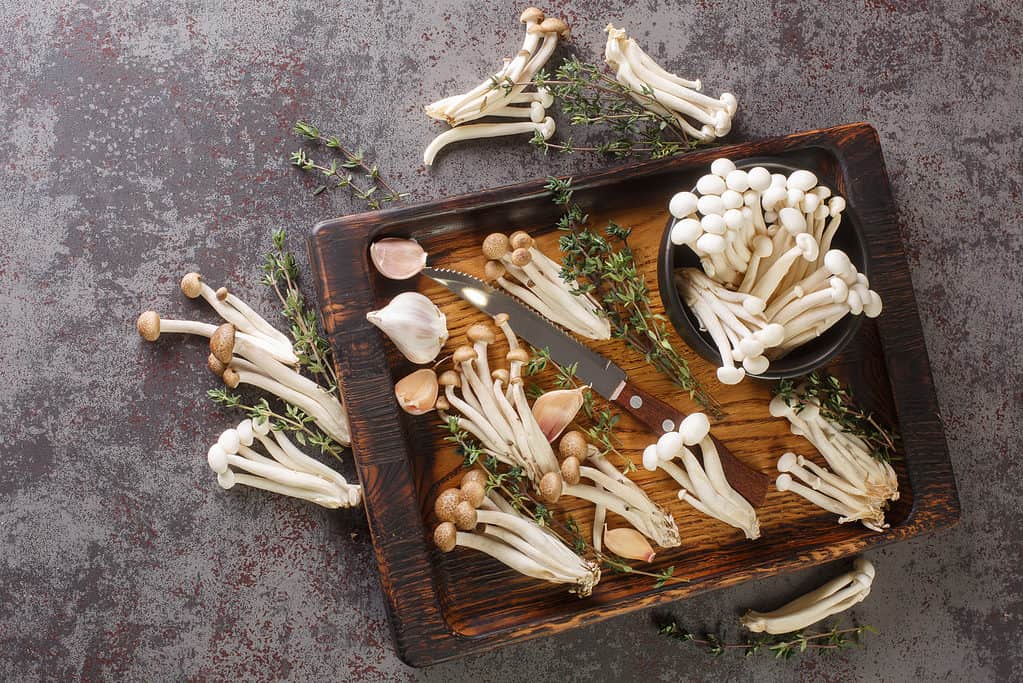
©iStock.com/ALLEKO
In comparison, many food experts enjoy enoki mushrooms raw for their crunchy texture. When cooked, these stems turn into a softer and more noodle-like consistency. Enoki mushrooms are mild in flavor and are a great conduit for sauces and other flavors because they absorb the spices or broth they are cooked in. To eat enoki mushrooms, trip the end of their stems and stir fry them in oil or with other ingredients such as vegetables. Like beech mushrooms, you can eat enoki mushrooms either raw or cooked. They taste sweet and slightly fruity.

©iStock.com/ma-no
Beech Mushrooms vs. Enoki Mushrooms: Health Benefits and Use
Like many other edible mushrooms species, eating beech mushrooms may bring many benefits. Beech mushrooms contain antioxidants, are rich in Vitamins B and D, have high levels of dietary fiber, offer potassium and copper, and are high in beta-glucan. Together, these vitamins and minerals can help fight cancer, support hormone regulation, improve digestion, and regulate the nervous system. They can also support good bone health, muscle formation, and a resilient immune system.
To obtain these health benefits, eat beech mushrooms cooked. Cooking them will help your body to absorb the nutrients contained in beech mushrooms.
Enoki mushrooms also have potential to support good health and bring many nutritional benefits to your diet. Enoki mushrooms have a high amount of dietary fiber; provide antioxidants to boost your immune system; are good source of multiple vitamins and minerals such as potassium, copper, selenium, sodium, niacin, and iron; and can help support digestion and heart health. Like with beech mushrooms, cook your enoki mushrooms first before eating them so that your body can absorb the nutrition they bring.
In Summary
Both beech mushrooms and enoki mushrooms are edible species native to geographies of Asia, where they grow in forest environments and are important members of cultural cuisine. They also have similar appearances, with long stems that bring a crunch and small caps, which impart flavor. Both enoki and beech mushrooms are among the most popular mushrooms in the world. Their rival is the shiitake. However, all three can be enjoyed in different recipes or even together. Eating mushrooms is known to bring numerous health benefits and can be a great addition to your diet. Which one you choose is often just a matter of taste and what is available to you. This article covered these similarities, as well as other differences. To tell the two apart, compare where they are growing, their coloring and overall appearance, and their flavor.
Up Next
- 10 Most Expensive Mushrooms in the World
- Shiitake Mushrooms: A Complete Guide
- Bolete Mushrooms vs. Porcini Mushrooms
The post Beech Mushrooms vs. Enoki Mushrooms appeared first on AZ Animals.
from Animal News, Facts, Rankings, and More! - AZ Animals https://ift.tt/vBVQlGk